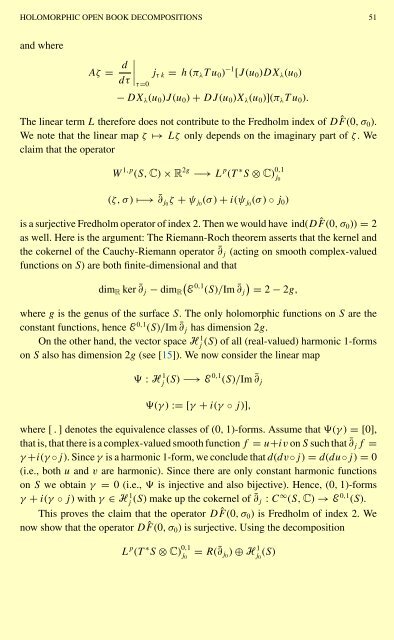NEAR OPTIMAL BOUNDS IN FREIMAN'S THEOREM
NEAR OPTIMAL BOUNDS IN FREIMAN'S THEOREM
NEAR OPTIMAL BOUNDS IN FREIMAN'S THEOREM
You also want an ePaper? Increase the reach of your titles
YUMPU automatically turns print PDFs into web optimized ePapers that Google loves.
HOLOMORPHIC OPEN BOOK DECOMPOSITIONS 51<br />
and where<br />
Aζ = d<br />
<br />
<br />
jτ<br />
dτ k = h (πλTu0)<br />
τ=0<br />
−1 [J (u0)DXλ(u0)<br />
− DXλ(u0)J (u0) + DJ(u0)Xλ(u0)](πλTu0).<br />
The linear term L therefore does not contribute to the Fredholm index of D ˆF (0,σ0).<br />
We note that the linear map ζ ↦→ Lζ only depends on the imaginary part of ζ .We<br />
claim that the operator<br />
W 1,p (S,C) × R 2g −→ L p (T ∗ S ⊗ C) 0,1<br />
j0<br />
(ζ,σ) ↦−→ ¯∂j0ζ + ψj0(σ ) + i(ψj0(σ ) ◦ j0)<br />
is a surjective Fredholm operator of index 2. Then we would have ind(D ˆF (0,σ0)) = 2<br />
as well. Here is the argument: The Riemann-Roch theorem asserts that the kernel and<br />
the cokernel of the Cauchy-Riemann operator ¯∂j (acting on smooth complex-valued<br />
functions on S) are both finite-dimensional and that<br />
<br />
dimR ker ¯∂j<br />
0,1<br />
− dimR E (S)/Im ¯∂j = 2 − 2g,<br />
where g is the genus of the surface S. The only holomorphic functions on S are the<br />
constant functions, hence E0,1 (S)/Im ¯∂j has dimension 2g.<br />
On the other hand, the vector space H 1 j (S) of all (real-valued) harmonic 1-forms<br />
on S also has dimension 2g (see [15]). We now consider the linear map<br />
: H 1<br />
j (S) −→ E0,1 (S)/Im ¯∂j<br />
(γ ):= [γ + i(γ ◦ j)],<br />
where [ . ] denotes the equivalence classes of (0, 1)-forms. Assume that (γ ) = [0],<br />
that is, that there is a complex-valued smooth function f = u+iv on S such that ¯∂jf =<br />
γ +i(γ ◦j).Sinceγ is a harmonic 1-form, we conclude that d(dv◦j) = d(du◦j) = 0<br />
(i.e., both u and v are harmonic). Since there are only constant harmonic functions<br />
on S we obtain γ = 0 (i.e., is injective and also bijective). Hence, (0, 1)-forms<br />
γ + i(γ ◦ j) with γ ∈ H 1 j (S) make up the cokernel of ¯∂j : C ∞ (S,C) → E 0,1 (S).<br />
This proves the claim that the operator D ˆF (0,σ0) is Fredholm of index 2. We<br />
now show that the operator D ˆF (0,σ0) is surjective. Using the decomposition<br />
L p (T ∗ S ⊗ C) 0,1<br />
j0 = R(¯∂j0) ⊕ H 1<br />
j0 (S)

















